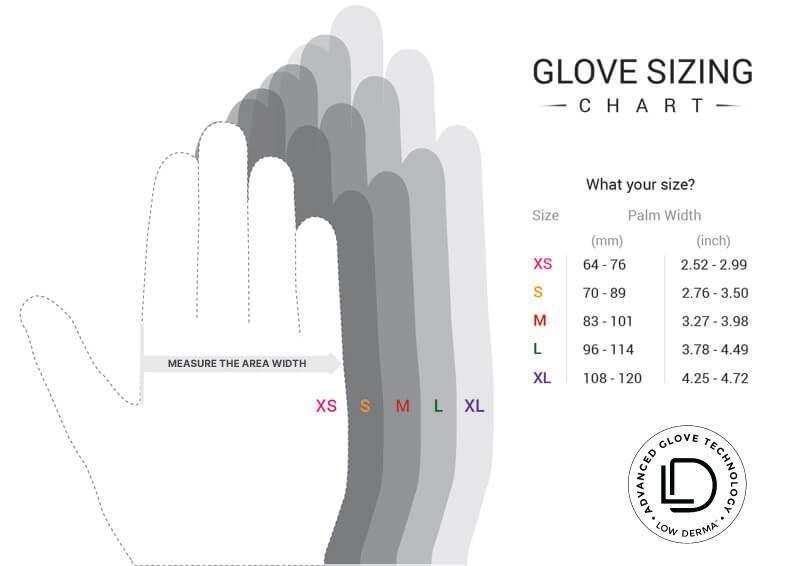Business Enquiry
Institutional Purchase
Not available in your country?
Frequently Asked Questions
1. LD Technology™
What is LOW DERMA™ Formula?
LOW DERMA™ Formula is a patented glove formula used in the production of nitrile gloves. Gloves made with this formula offer better allergy care and protection, both on the inside (allergies/exposure to potentially harmful chemicals found in gloves) and out (provides a protective barrier against harmful substances)
Gloves made with LOW DERMA™ Formula were the first to obtain US FDA 510K clearance for ‘Low Dermatitis Potential Claim’
Where did LD Technology™ originate from?
LD Technology™ originated from Malaysia.
When was LOW DERMA™ Formula invented?
LOW DERMA™ Formula was first formulated in 2005. After 4 years of extensive research, development and testing and compliance, it was finally granted a patent in 2009.
What type of gloves use LOW DERMA™ formula?
LOW DERMA™ Formula is found in many types/grades of gloves for different industries, namely: medical/healthcare, industrial, food handling/processing, chemical handling and cleanrooms.
How does LD Technology™ work in gloves?
It offers improved allergy care and protection especially if you're prone to:
Type IV Hypersensitivity
(sensitive to chemical accelerators like Thiurams, Thiazoles and Carbamates) or:
Type I Hypersensitivity
(sensitive to natural rubber latex protein)
Is LD Technology™ found in other types of gloves eg. latex or vinyl gloves?
No, LD Technology™ is exclusively used in the manufacture of nitrile gloves only.
2. Gloves with LD Technology™
How many brands use LD Technology™?
To date, there are 107 brands from 39 companies offering gloves manufactured using LD Technology™.
Where can I buy these gloves?
Whichever industry you're in, there's a glove brand that's right for you. Buy from one of the major online shopping sites, or contact us to find a reseller nearest to you.
How can I be sure that the gloves I bought are genuine LD Technology™ gloves?
Whenever you purchase a nitrile glove made using LOW DERMA™ Technology, always look for the ‘LOW DERMA™’ icon below. It is your assurance of a quality pair of gloves that offer better allergy care and protection.
Are gloves made using LD Technology™’s LOW DERMA™ formula better for allergy care?
LOW DERMA™ enhanced nitrile gloves are considered the better choice for allergy care. They were the first to be granted ‘Low Dermatitis Potential’ claim by U.S. FDA and also fulfil all the regulatory requirements in the 510(K) Premarket Notification. The gloves are also clinically tested (Modified Draize-95 and Dermatest)
3. Glove Allergies
What is contact dermatitis?
Contact dermatitis is an occupationally related skin condition that develops from frequent and repeated use of hand hygiene products, exposure to chemicals and glove use. It is classified as either irritant or allergic.
What is Irritant Contact Dermatitis?
It is a common, non-allergic condition that develops as dry, itchy, irritated areas on the skin around the area of contact.
It is usually caused by an irritant, such as the chemicals commonly used in the manufacture of hand products and gloves. It can also be caused by water, (including improper hand drying before donning gloves,) soaps, detergents, solvents, acids, alkalis and friction.
What is Allergic Contact Dermatitis (also known as Type I and Type IV allergy)?
Type I allergy is an immediate allergic reaction which can be fatal (anaphylactic shock) caused by protein found in natural rubber latex gloves.
Type IV allergy often manifests as an itchy, red rash, sometimes with small blisters, beginning approximately 6 to 48 hours after contact. Like irritant dermatitis, it is usually confined to the areas of contact. It can result from exposure to accelerators and other chemicals used in the manufacture of most latex and non-latex gloves.
What are chemical accelerators in gloves and how do they cause allergies?
Chemical accelerators are used to ‘accelerate’ the linkage of rubber molecules in natural rubber latex or synthetic rubber latex, such as nitrile and vinyl.
The chemicals transform the liquid rubber into a thin, strong and elastic glove film, and stabilizes the material.
Chemical accelerators – dithiocarbamates, thiurams and mercaptobenzothiazoles (MBT) – are sulfur-based and are the cause of the majority of skin dermatitis reactions.
Are LD gloves accelerator-free?
Gloves manufactured using LD Technology™ are accelerator-free. Because of the breakthrough cross-linking technology that does not use chemical accelerators, the result is a thin, soft and stretchy glove that is skin-friendlier and safer than traditionally manufactured rubber gloves.
What is ‘Low Dermatitis Potential’ claim?
Gloves made using LD Technology™ carry the U.S. FDA-approved claim ‘Low Dermatitis Potential’ reserved for gloves that have been clinically tested.
What is the difference between Type I and Type IV Allergies?
Type I Allergy covers allergies from proteins found in natural rubber/latex
Type IV Allergy covers allergies from chemical accelerators found in rubber gloves
I don’t suffer from glove allergies, so why should I use gloves made with LD Technology™?
Even if you don’t suffer from any such allergies at the moment, prolonged use and exposure to chemical accelerators in rubber gloves may, however, eventually cause delayed Type IV allergy.
All gloves made using LD Technology™ DO NOT use any chemical accelerators in the manufacturing process.
I am currently using gloves with LD Technology™ but my allergies are not getting better. Why?
In cases like yours, it is recommended that you consult a dermatologist to conduct a patch test to rule out other causes such as:
- Exposure to irritants from gloves
- Prolonged wearing of gloves or from sweating that could impair skin barrier integrity
- Pre-existing conditions of skin impairment due to dryness caused by work environment or frequent hand-washing
- Using the wrong type of gloves that does not provide adequate protection resulting in exposure to substances that irritate the skin
4. Glove Materials & Features
What are the different types of glove materials?
Gloves are generally either rubber or plastic.
Rubber gloves are made from natural latex, nitrile butadiene, polyvinyl chloride (PVC), neoprene, or polyisoprene
Plastic gloves are made from polyethylene (PE)
What is the difference between examination gloves and disposable gloves?
Examination gloves are categorised as medical grade, primarily used in healthcare settings. They normally subject to testing for exposure to pathogens, chemicals and chemotherapy drugs.
Disposable gloves are non-medical grade meant for all other uses
What is the difference between ‘Low Dermatitis Potential’ and ‘Accelerator-Free’ nitrile gloves?
The crucial difference between both gloves is ‘ Low Dermatitis Potential’ gloves comply with regulations while ‘Accelerator-Free’ nitrile gloves are NOT.
To be labelled ‘Low Dermatitis Potential’, the gloves required clinical testing (Modified Draize-95 Test) and 510(K) Pre-market Notification clearance from United States Food & Drugs Administration (U.S. FDA). Test subjects demonstrated reduced potential for sensitising users to chemical additives
U.S. FDA guidelines specify ‘accelerator-free’ as misbranding. 'Accelerator-free' claim may not be accurate because it is not possible to absolutely and reliably assure that there is an absence of accelerators in the gloves if there are no clinical data.
Are ALL examination gloves suitable for use in chemotherapy setting?
No. Not all examination gloves can be used in chemotherapy. You must only use examination gloves that have been specifically tested against chemotherapy drugs permeation.
Why do gloves come in different colors?
Gloves are designed in different colors for specific reasons.
These include:
- Increased visibility/eye comfort
Example: Green helps surgeons see better in the operating room because it is the exact opposite of red on the color wheel. Because of this, the green and blue colors not only help to improve a surgeon's visual acuity but also make them more sensitive to different shades of red. - Focus
Neutral colors help the eye to better focus on the task at hand without being distracted. Some people who are averse to the sight of blood also prefer certain colored gloves to help them better focus on their tasks instead. - Sectioning and coding purpose
- Primary risk indicator through visual contrast
- Tidiness
Why are some gloves thicker than others?
- Gloves come in different weights which in turn affect their thickness
- Thicker gloves offer higher protection against punctures/tears, and also when handling harmful chemicals, preventing them from permeating through to the skin.
- Some gloves are considered ‘harder’ gloves which may give the impression that they are thicker where in fact they are actually the same thickness as a soft-compound glove of the same weight.
What is the shelf life of gloves?
Gloves are generally good for use within 3 years from the date of manufacture, after which their safety and integrity are compromised and no longer acceptable.
5. How To Choose The Right Gloves
How do I choose the best glove material for me?
Gloves are designed specifically for use in different industries. Please refer to the list below for recommended gloves for your particular industry:
Soft vs stiff gloves?
Gloves that are soft do not imply they are more inferior in performance, nor are they thinner compared to the same glove specification that is harder/stiffer. However, soft gloves offer better hand comfort that help prevent motor-skill diseases.
What other glove features should I be aware of when buying gloves?
- Grip
- Tactile sensitivity
- Softness
6. How To Correctly Use Gloves
Can I reuse disposable gloves?
No. Once gloves have been used in the way they are intended and removed from the hand, they lose their protective qualities, and their integrity has been compromised. Disposable gloves are meant to be used once, then discard accordingly.
How long can I wear a glove for?
It is best to change to a new pair of gloves every 4 hours or so. For the handling of chemicals and biohazards, please refer to the material safety chart or follow healthcare protocols on protective clothing guide.
When should I double-glove?
You should double-glove if you are being exposed to high-level risks like sharp objects, biohazards, viruses or hazardous drugs/chemicals.
What are the benefits of double gloving?
Double gloving offers glove users an additional layer of protection and indicates an urgent need for a change of gloves when the outer glove is visibly damaged by sharp objects, hazardous chemicals and contamination exposure.
What is the difference between wearing a dual-coloured glove vs. double-gloving?
Double gloving protects when perforation is detected by the stain mark visibility (liquid leak) and tearing when the under glove is highly visible. In contrast, breach detection for dual coloured gloves will only be visible when the glove encounters severe damage, and the inner glove colour becomes noticeable.
How do I properly remove gloves from my hands?
Hold the cuff of the glove and pull it away from your hand. Flip the glove inside-out when doffing.
How do I properly dispose of used gloves?
General waste disposal – for gloves that are NOT contaminated with biofluids or hazardous drugs/chemicals.
Medical waste disposal (incineration/landfill) – for gloves that are contaminated with biofluids or hazardous drugs/chemicals.
7. Important Glove Features Users Should Be Aware Of
Why is good grip in gloves important?
Grip, or surface tack, is a vital factor in glove selection.
The level of grip is characterised by the type of coating on the gloves, and some of which also comes with textured surfaces that potentially improve the gripping ability.
Potential health risks caused by poor grip:
- Hand fatigue due to overcompensation of hand muscles
- Musculoskeletal injuries from gripping too hard
- Risk of objects being dropped or slipping
- Risk of injury to other parts of the body
- Increased risk of cuts caused by lack of control
What is Tactile Sensitivity and why is it important?
Tactile sensitivity or touch sensitivity is directly related to glove thickness. The thicker the gloves, the more it can impair the user’s touch sensations.
Glove formulation also affects the level of sensitivity. Thick but soft-compound formulated gloves provide better tactile sensitivity compared to hard-compound formulated ones with an equivalent thickness.
In healthcare, Tactile sensitivity is crucial for the protection of both doctors and nurses, and the patients they are treating. For example, a dentist who frequently handles sharp tools while diagnosing the patient requires tactile sensitivity to avoid accidental mishandling of tools while performing the task.
Why does glove softness matter?
Softer gloves provide better comfort and also help to ease the agility of motor skills while reducing hand fatigue.
What are the functions of different glove colours?
- Risk indicator
Proper glove colour selection results in better functional visual contrasts. Depending on the nature of the work, accidental exposure to contaminants or hazardous risks can be quickly identified, acting as a primary risk indicator, and prompting an immediate change of gloves to avoid cross-contamination.
- Psychological benefits
Disposable gloves are generally available in lighter or brighter colours. However, darker coloured gloves began to gain popularity for its ability to mask blood, dirt, dyes and stains. Masking of blood is beneficial when treating patients who suffer from haemophobia (fear of blood). For industries that handle dirt, dye or materials that stain, masking such exposure helps to maintain a clean and professional impression at work.
- Concentration of task at hand
Light/bright or dark coloured, all gloves are functional when it comes to material or equipment handling. Light/bright coloured gloves are functional when handling dark coloured materials or equipment, and vice versa. Choosing the right glove colour ensures optimum contrasting ability and better handling precision.
<!--
-->
What are the consequences of glove barrier protection failures?
- Risk of Permeation
Occurs when a chemical passes through the glove layer at the molecular level. Permeation is known as the “silent killer” and only the glove material safety data sheet will be able to provide accurate information on the chemical permeation performance.
Please refer to the Material Safety Data printed on the glove packaging to determine the glove-use suitability as it will indicate the permeation duration for specific chemicals. Normally the performance can be found on the glove packaging, otherwise check with the glove supplier to obtain the Material Safety Data.
- Risk of penetration
Occurs when a chemical passes through a seam or damaged part of the glove, for example, a pinhole or tear. Sometimes small pinholes or tears can go unnoticed until it is too late to initiate a change of gloves.
- Risk of degradation
Occurs when a chemical damages the glove material causing the glove to be less resistant and causing a physical breakdown of the glove polymer. Normally leads to visible signs of swelling, softening / stiffening, cracking, shrinking, wrinkling, discolouration.
- Risk of contamination
Occurs when the wrist opening is contaminated with a chemical, most likely due to poor donning or doffing practices.
8. Clinical Tests
What does ‘Clinically Tested’ mean in LD gloves’ claim?
It means the glove formula has been clinically tested on human subjects under a dermatologist’s supervision against Type IV Allergy (allergy caused by chemical accelerators namely thiurams, thiazoles, carbamates)
What is Modified Draize 95 test?
It is an intensive patch test requirement set by U.S. FDA where at least 200 human test subjects with thorough medical background check performed (Example: ethnicity, gender, age) undergo the test to prove the confidence level of at least 98.5% that the test does not induce Type IV Allergy cause by chemical accelerators (thiurams, thiazoles, carbamates).
What is Dermatest 5 star seal?
It’s a patch test conducted by an independent German Dermatology Institute. The 5 Star Guarantee Seal can only be obtained when the tested gloves pass the long-term application tests to prove that it is able to provide the maximum possible protection against skin sensitisation.
9. Glove Chemical Accelerators
What type of gloves contains chemical accelerators?
Nitrile, latex, butyl, viton, chloroprene/polyisoprene all contain chemical accelerators.
For details, please refer to article:
If chemical accelerators are harmful, why are they still in use in glove manufacturing?
Certain manufacturers rely on the use of chemical accelerators together with sulphur to enable a glove film to form properly to provide the glove’s intended protection.
Is plasticiser a type of chemical accelerator found in gloves?
Plasticisers (also known as phthalate) are not classified as chemical accelerators but may be carcinogenic and could also be toxic to the environment. They are found in 30% of the actual glove weight of polyvinyl chloride (PVC) gloves and plastic gloves.
Benefits of light colour glove application
Scroll left and right to view full table
| Industry | Light / Bright Coloured Glove |
|---|---|
| Healthcare |
|
| Laboratory |
|
| Automotive |
|
| First Responder (Law Enforcement, EMS, Firefighter) |
|
Benefits of dark colour glove application
Scroll left and right to view full table
| Industry | Dark Coloured Glove |
|---|---|
| Healthcare |
|
| Laboratory |
|
| Automotive |
|
| First Responder (Law Enforcement, EMS, Firefighter) |
|
| Tattoo |
|
| Beauty Industry |
|
Steps In Choosing The Right Glove
Identify The Hazard
- Biofluids and Infectious Diseases
- Extreme temperatures
- Hazardous chemicals
- Sharp Instruments
- Irritants
Glove Material Selection (1)(2)(3)
Scroll left and right to view full table
| Type of Materials | |||
|---|---|---|---|
| Profile | Latex | Nitrile | Vinyl |
| Nature | Natural Rubber + Chemical Accelerators | Synthetic + Chemical Accelerators | Synthetic + Plasticisers |
| Pros and Cons | Short shelf life, Most elastic, resilient and form-fitting material, Biodegradable, consist of protein (Type I Hypersensitivity), Chemical Accelerators (Type IV Hypersensitivity) | Long shelf life, Some with no Chemical Accelerators (Type IV Hypersensitivity), can be biodegradable, protein-free | Long shelf life, Non-biodegradable, protein-free, carcinogenic |
| Colour | Normally white | Colourful | Normally translucent or white |
| Protection | |||
| Viral Penetration | O | O | |
| Oil Resistance | O | O | |
| Chemical Resistance | O | O | O (Non-hazardous only) |
| Chemotherapy Drugs | O | O | |
| Puncture Resistance | O | O | |
| Tear Resistance | O | ||
| Cut Resistance | O | O | |
| Performance | |||
| Dexterity | O | O | |
| Grip | O | O | |
| Tactile Sensitivity | O | O | |
| Softness | O | O | |
| Areas | Impact |
|---|---|
| Glove Thickness / Double gloving | Level of Resistance to permeation, puncture, cuts, abrasion, contamination, and level of tactile sensitivity |
| Glove Length | Level of Protection Coverage |
| Elasticity | Level of comfort and hand fatigue |
| Duration of Use | Eliminate the risk of accidental exposure due to glove failure |
| Glove Texture | Level of grip, tactile sensitivity |
Scroll left and right to view full table
| Occupation / Industry | ||||||||
|---|---|---|---|---|---|---|---|---|
| Protection | Industrial / Manufacturing | Healthcare | Laboratory | First Responders | Beauty | Janitorial | Food Handling | Cleanroom |
| Viral Penetration | O | O | O | |||||
| Chemical Resistance | O | O (chemical exposure) |
O | O (opioid exposure) |
O | O | O (pharma cleanroom) |
|
| Chemotherapy Drugs | O (Drug Compounding) |
O | O | |||||
| Oil Handling | O | |||||||
| Puncture Resistance | O | O | ||||||
| Double Gloving | O (hazardous chemicals) |
O (chemotherapy drugs) |
O (hazardous drugs) |
O (illicit drugs, sharp materials) |
||||
| Low Particle Count | O | |||||||
| Allergy | O | O | O | O | O | O | O | O |
Disclaimers:
- This is a glove selection recommendation reference for medical and non-medical grade applications. For compliance, it is advisable to refer to your respective country’s regulatory and compliance requirements.
- The suggestions are based on overall industries and the potential hazard exposures. It is recommended to first identify the type of hazard/risk exposure at your workplace before going through the selection process, as some suggestions may not be necessary.
Select The Correct Glove Size


















